一般过去时态
- 格式:ppt
- 大小:2.11 MB
- 文档页数:25
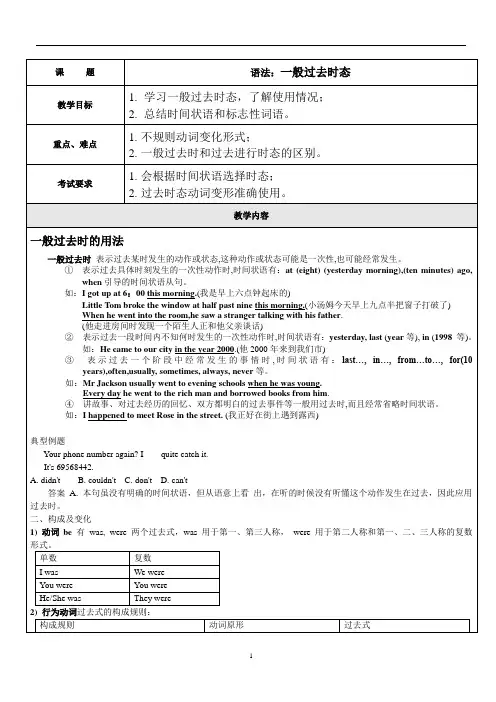
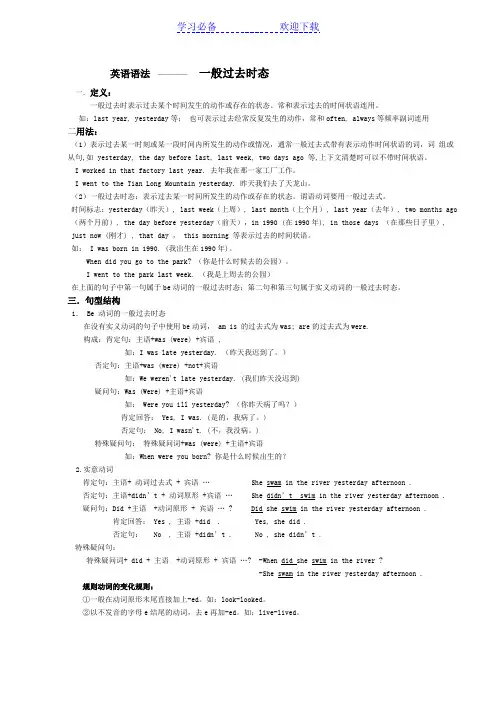
英语语法————一般过去时态一.定义:一般过去时表示过去某个时间发生的动作或存在的状态。
常和表示过去的时间状语连用。
如:last year, yesterday等;也可表示过去经常反复发生的动作,常和often, always等频率副词连用二用法:(1)表示过去某一时刻或某一段时间内所发生的动作或情况,通常一般过去式带有表示动作时间状语的词,词组或从句,如 yesterday, the day before last, last week, two days ago 等,上下文清楚时可以不带时间状语。
I worked in that factory last year. 去年我在那一家工厂工作。
I went to the Tian Long Mountain yesterday. 昨天我们去了天龙山。
(2)一般过去时态:表示过去某一时间所发生的动作或存在的状态。
谓语动词要用一般过去式。
时间标志:yesterday(昨天), last week(上周), last month(上个月), last year(去年), two months ago (两个月前), the day before yesterday(前天),in 1990 (在1990年), in those days (在那些日子里), just now (刚才) , that day , this morning 等表示过去的时间状语。
如: I was born in 1990. (我出生在1990年)。
When did you go to the park? (你是什么时候去的公园)。
I went to the park last week. (我是上周去的公园)在上面的句子中第一句属于be动词的一般过去时态;第二句和第三句属于实义动词的一般过去时态。
三.句型结构1. Be 动词的一般过去时态在没有实义动词的句子中使用be动词, am is 的过去式为was; are的过去式为were.构成:肯定句:主语+was (were) +宾语 ,如:I was late yesterday. (昨天我迟到了。
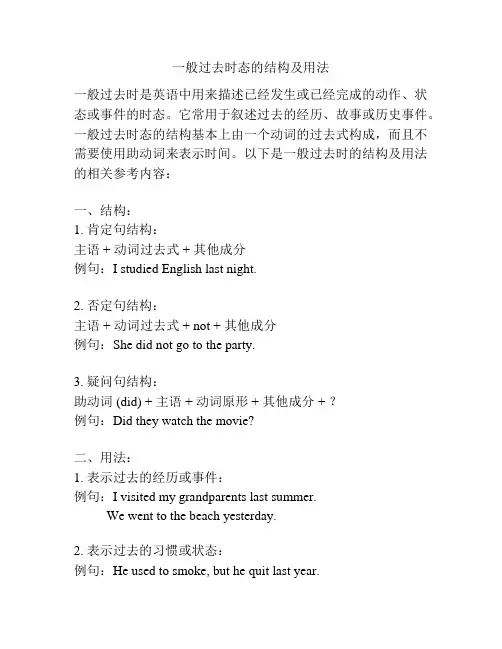
一般过去时态的结构及用法一般过去时是英语中用来描述已经发生或已经完成的动作、状态或事件的时态。
它常用于叙述过去的经历、故事或历史事件。
一般过去时态的结构基本上由一个动词的过去式构成,而且不需要使用助动词来表示时间。
以下是一般过去时的结构及用法的相关参考内容:一、结构:1. 肯定句结构:主语 + 动词过去式 + 其他成分例句:I studied English last night.2. 否定句结构:主语 + 动词过去式 + not + 其他成分例句:She did not go to the party.3. 疑问句结构:助动词 (did) + 主语 + 动词原形 + 其他成分 + ?例句:Did they watch the movie?二、用法:1. 表示过去的经历或事件:例句:I visited my grandparents last summer.We went to the beach yesterday.2. 表示过去的习惯或状态:例句:He used to smoke, but he quit last year.We lived in London for ten years.3. 在时间状语从句中:例句:I saw her while I was walking home.He was cooking dinner when the phone rang.4. 与过去的比较或对比:例句:She was much taller when she was young.It was colder last winter than this winter.5. 与现在进行时态的对比:一般过去时表示的是过去的动作或状态,而现在进行时表示的是现在正在进行的动作或状态。
例句:Last night, I studied for the exam. (过去发生的动作)Right now, I am studying for the exam. (现在正在进行的动作)6. 与过去进行时态的对比:一般过去时表示的是过去的动作或状态,而过去进行时表示的是过去某个时间点正在进行的动作。
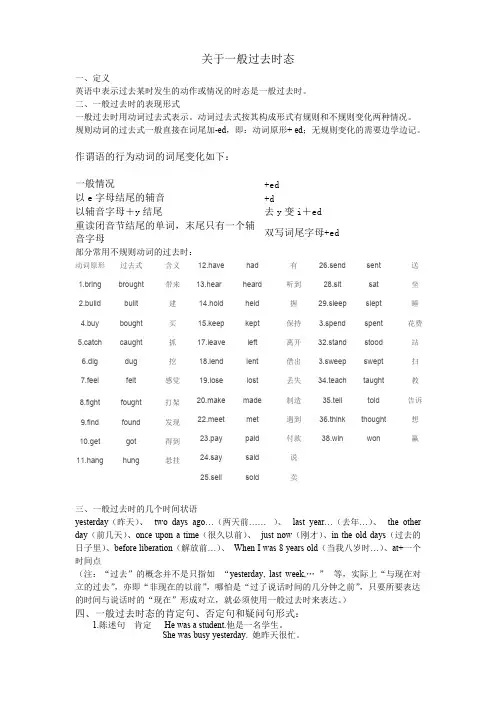
关于一般过去时态一、定义英语中表示过去某时发生的动作或情况的时态是一般过去时。
二、一般过去时的表现形式一般过去时用动词过去式表示。
动词过去式按其构成形式有规则和不规则变化两种情况。
规则动词的过去式一般直接在词尾加-ed,即:动词原形+ ed;无规则变化的需要边学边记。
作谓语的行为动词的词尾变化如下:一般情况+ed以e字母结尾的辅音+d以辅音字母+y结尾去y变i+ed重读闭音节结尾的单词,末尾只有一个辅音字母双写词尾字母+ed部分常用不规则动词的过去时:动词原形过去式含义1.bring brought带来2.build built建4.buy bought买5.catch caught抓6.dig dug挖7.feel felt感觉8.fight fought打架9.find found发现10.get got得到11.hang hung悬挂12.have had有13.hear heard听到14.hold held握15.keep kept保持17.leave left离开18.lend lent借出19.lose lost丢失20.make made制造22.meet met遇到23.pay paid付款24.say said说25.sell sold卖26.send sent送28.sit sat坐29.sleep slept睡3.spend spent花费32.stand stood站3.sweep swept扫34.teach taught教35.tell told告诉36.think thought想38.win won赢三、一般过去时的几个时间状语yesterday(昨天)、two days ago…(两天前…… )、last year…(去年…)、the other day(前几天)、once upon a time(很久以前)、just now(刚才)、in the old days(过去的日子里)、before liberation(解放前…)、When I was 8 years old(当我八岁时…)、at+一个时间点(注:“过去”的概念并不是只指如“yesterday, last week,…”等,实际上“与现在对立的过去”,亦即“非现在的以前”,哪怕是“过了说话时间的几分钟之前”,只要所要表达的时间与说话时的“现在”形成对立,就必须使用一般过去时来表达。
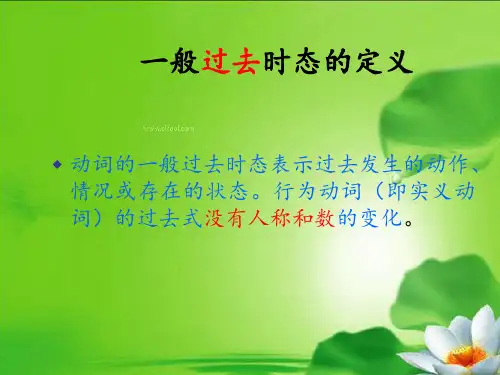
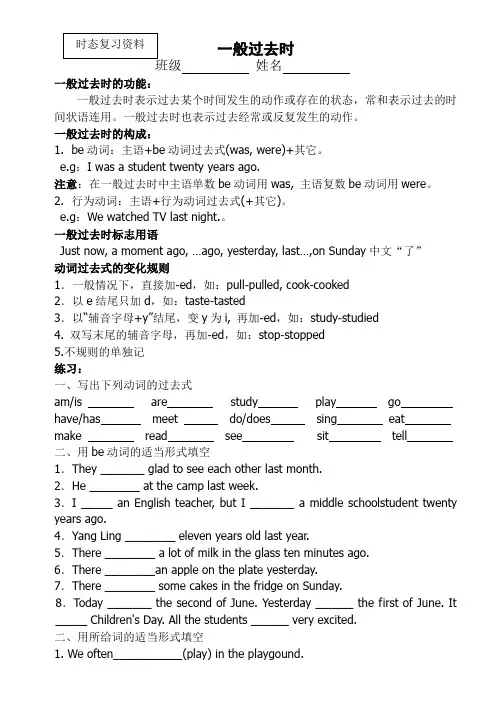
一般过去时班级姓名一般过去时的功能:一般过去时表示过去某个时间发生的动作或存在的状态,常和表示过去的时间状语连用。
一般过去时也表示过去经常或反复发生的动作。
一般过去时的构成:1.be动词:主语+be动词过去式(was, were)+其它。
e.g:I was a student twenty years ago.注意:在一般过去时中主语单数be动词用was, 主语复数be动词用were。
2.行为动词:主语+行为动词过去式(+其它)。
e.g:We watched TV last night.。
一般过去时标志用语Just now, a moment ago, …ago, yesterday, last…,on Sunday中文“了”动词过去式的变化规则1.一般情况下,直接加-ed,如:pull-pulled, cook-cooked2.以e结尾只加d,如:taste-tasted3.以“辅音字母+y”结尾,变y为i, 再加-ed,如:study-studied4. 双写末尾的辅音字母,再加-ed,如:stop-stopped5.不规则的单独记练习:一、写出下列动词的过去式am/is are study play gohave/has meet do/does sing eatmake read see sit tell二、用be动词的适当形式填空1.They _______ glad to see each other last month.2.He ________ at the camp last week.3.I _____ an English teacher, but I _______ a middle schoolstudent twentyyears ago.4.Yang Ling ________ eleven years old last year.5.There ________ a lot of milk in the glass ten minutes ago.6.There ________an apple on the plate yesterday.7.There ________ some cakes in the fridge on Sunday.8.Today _______ the second of June. Yesterday ______ the first of June. It_____ Children's Day. All the students ______ very excited.二、用所给词的适当形式填空1. We often___________(play) in the playgound.2. He _________(see) a play last Friday.3. What (do) he usually (do) after school?4. Danny (study) English,Chinese,Maths, Science and Art at school.5. The sign on the grass (mean)‘Keep off the grass’.6. ________ Mike________(read) English every day?7. Did you (fly) kites? No, I (make) a kite.8. Where you a moment ago? I in the bedroom. (be)9. We _______ (have) a party last Halloween.10. __ they _____ (play) chess in the classroom last PE lesson?11. My parents didn’t ________ (work) last Friday.12、I ________ (not taste) oranges on the farm yesterday.三、中译英1. 我们上周五看了一部电影。
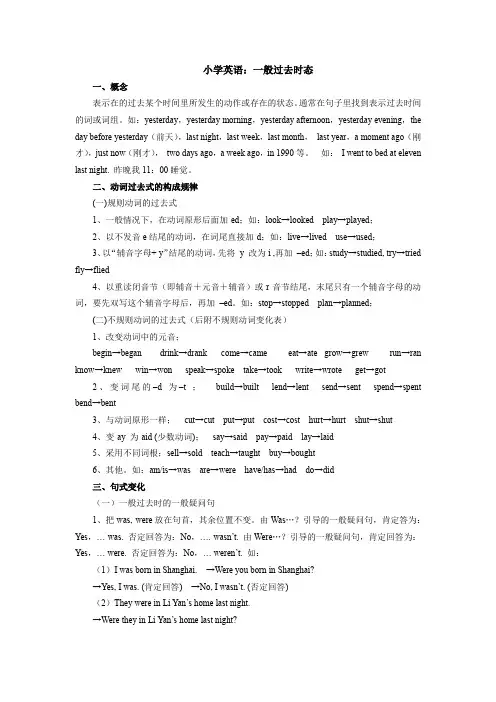
小学英语:一般过去时态一、概念表示在的过去某个时间里所发生的动作或存在的状态。
通常在句子里找到表示过去时间的词或词组。
如:yesterday,yesterday morning,yesterday afternoon,yesterday evening,the day before yesterday(前天),last night,last week,last month,last year,a moment ago(刚才),just now(刚才),two days ago,a week ago,in 1990等。
如:I went to bed at eleven last night. 昨晚我11:00睡觉。
二、动词过去式的构成规律(一)规则动词的过去式1、一般情况下,在动词原形后面加-ed;如:look→looked play→played;2、以不发音e结尾的动词,在词尾直接加-d;如:live→lived use→used;3、以“辅音字母+ y”结尾的动词,先将y 改为i ,再加–ed;如:study→studied, try→tried fly→flied4、以重读闭音节(即辅音+元音+辅音)或r音节结尾,末尾只有一个辅音字母的动词,要先双写这个辅音字母后,再加–ed。
如:stop→stopped plan→planned;(二)不规则动词的过去式(后附不规则动词变化表)1、改变动词中的元音;begin→began drink→drank come→came eat→ate grow→grew run→ran know→knew win→won speak→spoke take→took write→wrote get→got2、变词尾的–d 为–t ;build→built lend→lent send→sent spend→spent bend→bent3、与动词原形一样;cut→cut put→put cost→cost hurt→hurt shut→shut4、变-ay 为-aid (少数动词);say→said pay→paid lay→laid5、采用不同词根;sell→sold teach→taught buy→bought6、其他。
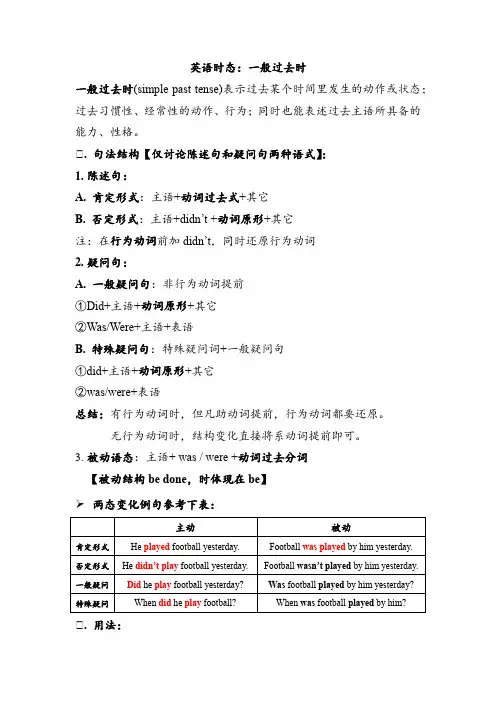
英语时态:一般过去时一般过去时(simple past tense)表示过去某个时间里发生的动作或状态;过去习惯性、经常性的动作、行为;同时也能表述过去主语所具备的能力、性格。
Ⅰ. 句法结构【仅讨论陈述句和疑问句两种语式】:1.陈述句:A. 肯定形式:主语+动词过去式+其它B. 否定形式:主语+didn’t +动词原形+其它注:在行为动词前加didn’t,同时还原行为动词2.疑问句:A. 一般疑问句:非行为动词提前①Did+主语+动词原形+其它②Was/Were+主语+表语B. 特殊疑问句:特殊疑问词+一般疑问句①did+主语+动词原形+其它②was/were+表语总结:有行为动词时,但凡助动词提前,行为动词都要还原。
无行为动词时,结构变化直接将系动词提前即可。
3.被动语态:主语+ was / were +动词过去分词【被动结构be done,时体现在be】➢两态变化例句参考下表:Ⅰ. 用法:1.一般过去时表示在过去某个特定时间发生,也可以表示过去习惯性、经常性的动作。
(一般不强调动作的影响,只说明的事情。
)I talked with Catherine yesterday morning.His mother cooked him breakfast.2.一般过去时常与表示过去的时间状语或从句连用,如:yesterday, last week, in the past, in 1993, at that time, once, during the war, before, a few days ago, when 等。
3.表示过去连续发生的动作时,要用过去时。
这种情况下,往往没有表示过去的时间状语,而通过上下文来表示。
The boy cried for a while,and then drank a cup of tea.4.表示在此之前一段时间内经常或反复的动作。
常与always,never 等连用。
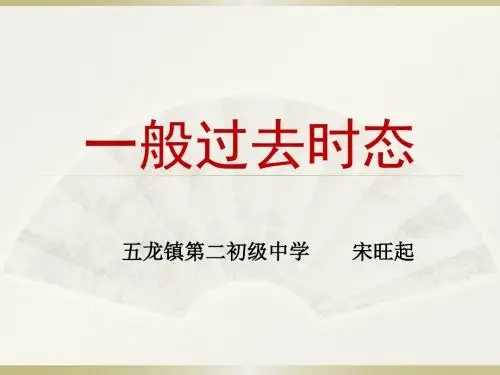
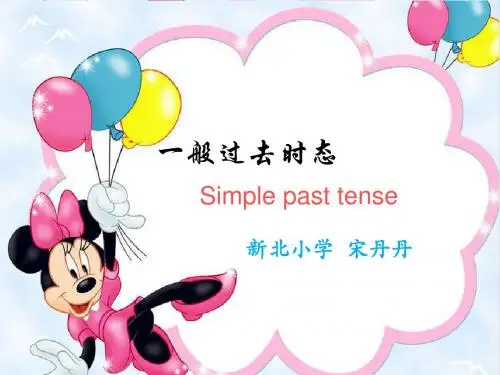
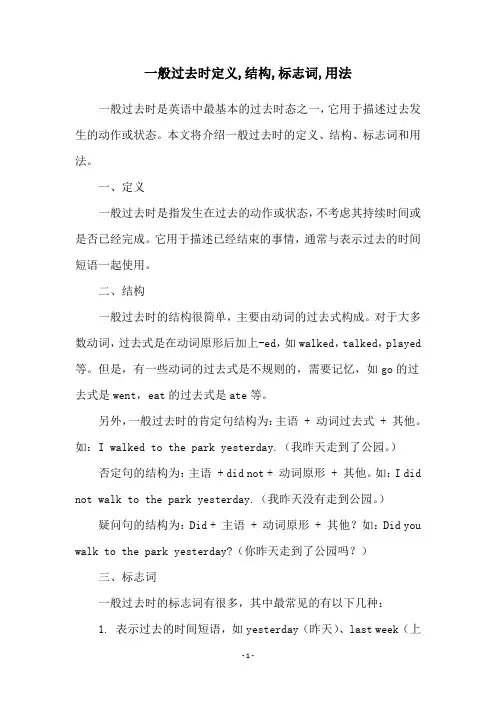
一般过去时定义,结构,标志词,用法一般过去时是英语中最基本的过去时态之一,它用于描述过去发生的动作或状态。
本文将介绍一般过去时的定义、结构、标志词和用法。
一、定义一般过去时是指发生在过去的动作或状态,不考虑其持续时间或是否已经完成。
它用于描述已经结束的事情,通常与表示过去的时间短语一起使用。
二、结构一般过去时的结构很简单,主要由动词的过去式构成。
对于大多数动词,过去式是在动词原形后加上-ed,如walked,talked,played 等。
但是,有一些动词的过去式是不规则的,需要记忆,如go的过去式是went,eat的过去式是ate等。
另外,一般过去时的肯定句结构为:主语 + 动词过去式 + 其他。
如:I walked to the park yesterday.(我昨天走到了公园。
)否定句的结构为:主语 + did not + 动词原形 + 其他。
如:I did not walk to the park yesterday.(我昨天没有走到公园。
)疑问句的结构为:Did + 主语 + 动词原形 + 其他?如:Did you walk to the park yesterday?(你昨天走到了公园吗?)三、标志词一般过去时的标志词有很多,其中最常见的有以下几种:1. 表示过去的时间短语,如yesterday(昨天)、last week(上个星期)、in 1999(在1999年)等。
2. 过去式的动词,如walked(走)、talked(谈话)、played(玩)等。
3. 过去式的助动词did,如did not(没做)、did you(你做了吗?)等。
四、用法一般过去时通常用于以下情况:1. 描述过去的事件或状态,如:I went to the park yesterday.(我昨天去了公园。
)2. 描述过去的习惯或经常性动作,如:When I was a child, I played with dolls every day.(我小时候每天都和玩偶玩。
一般过去时定义:一般过去时表示在过去的某一时候或某一时间段所发生的事情或存在的状态;表示过去的时间状语,如yesterday, the day before yesterday, last night, three days ago,just now等等;构成结构:1一般过去时的肯定陈述句:主语+动词过去式+宾语或表语;例:I played basketball yesterday. I was 11 years old last year.2 一般过去时的否定陈述句:主语+didn’t+动词原形行为动词+宾语;例:I didn’t play basketball yesterday.主语+wasn’t/weren’t +表语;例:I wasn’t 11 years old last year.3 一般过去时的一般疑问句:Did+主语+动词原形行为动词+宾语例:Did you play basketball yesterday注意在陈述句变成疑问句时,第一人称需变为第二人称,如果是其它人称是不需要变化的Was/Were +主语+表语例:Were you 11 years old last year 注意在陈述句变成疑问句时,第一人称需变为第二人称,如果是其它人称是不需要变化的,而有be动词时,be动词需随主语而变化4 一般过去时的特殊疑问句:特殊疑问词+did +主语+动词原形行为动词+宾语例:What did you do yesterday特殊疑问词+was/were+主语+表语例:How old were you last year附表格,以行为动词work为例:注意:在一般过去时的句子中,如果使用了助动词did, didn’t等,尽管主语是第三人称单数,谓语动词也无需再变化;如:He didn’t go to the cinema last night.动词过去式的规则变化:1.一般情况下,在动词原形后直接加ed:work-- worked ,clean--cleaned2.以不发音的e结尾的词,直接加d:live --lived3 以辅音字母+y结尾的词,变y为i加ed:study--studied4以元音字母+y结尾的词,直接加ed:enjoy--enjoyed ,play--played5 以重读闭音节辅音+元音+辅音结尾的词,双写最后的辅音字母+ed:stop--stopped不过许多常用的动词的过去式的变化都是不规则的,这就需要大家花时间逐个去记:have/has -- had,eat--ate, see—saw,am/is—was, are—were, go—went, do—did, take--took, run--ran, lend--lent, sleep--slept,get—got, meet—met, bring—brought, buy—bought, think—thought, say—said, give—gave, put—put, speak—spoke, teach—taught,write—wrote, wake—woke, fall—fell, know—knew等等同步测试:一、写出下列动词的过去式;___________ ______________________ ___________ ______________________ ___________ _____________________ ___________ _____________________ ___________ ______________________ ___________ ____________________ ___________ __________________ ___________ ____________________ ___________ ______________________ ___________二、按要求改写下列各句;1. I was at home this morning. 改为一般疑问句,并作否定回答___________________at home this morning__________, ____________.2. He did morning exercises in the morning. 改为否定句He________________________________________ in the morning.3. They had a big dinner yesterday. 改为一般疑问句,并作肯定回答________________________ a big dinner yesterday____________,_______________ .4. Mr. Wang went to America by plane. 对划线部分提问________________Mr. Wang_______________ to America5. He practices the guitar every day.用yesterday作时间状语改写句子He___________the guitar________________ .6. I came here five years ago. 对划线部分提问___________ you______________ here7. They moved to France because their father found a job there.对划线部分提问____________they_________________ to France8. I can't swim. 用last year作时间状语改写句子I ___________________________________.9. I went to see my uncle last Sunday. 改为否定句I _______________________to see my uncle last Sunday.10. Tom had an egg this morning. 对划线部分提问What________________Tom________________this morning三、用所给动词的适当形式填空;1 Jim____ watch TV last night.2 Lucy ________ leave the classroom half an hour ago..3 They ________ ride a bike to school yesterday.4 ________ she ________ fall down the tree just now5 I ________ losemy watch last week.6 Where ________ you ________ catch the fish-I ________ catch it in the river near the house.四、选择下列所给动词并用其适当形式填空;cook, stay, say, tell, visit, come, think, take, be, eatLast Sunday it was snowy. Maria 1at home. Her cousin Cara 2to visit her. She came back from Beijing. She 3Maria something about her vacation. “It was pretty good," she said. Cara 4the Palace Museum and the Great Wall. She 5 a lot of photos.It was lunch time. Maria's parents 6not at home. They decided to cook by themselves. Maria 7noodles with some tomatoes and pepper 辣椒. After Cara 8up the noodles, she said slowly, “I think it is delicious” But Maria 9the food was too bad. She 10,“Cara, thank you, but I put too much pepper into it.五、句子转换;1、she was in the kitchen .否定句:一般疑问句:特殊疑问句:2、They were in a spaceship.否定句:一般疑问句:特殊疑问句:3、I visited a friend.否定句:一般疑问句:特殊疑问句:4、They cleaned the house yesterday. 否定句:一般疑问句:特殊疑问句:5、She had an English class.一般疑问句:6、I was at home.否定句:一般疑问句:7、we went to school last week.否定句:一般疑问句:特殊疑问句:8、They weren’t at home yesterday. 肯定句:一般疑问句:特殊疑问句:9、Did you read a book last night肯定句:否定句:特殊疑问句:特殊疑问句:。
一般过去时态一般过去时表示过去某一时候发生的动作或存在的状态。
常与一般过去时连用的时间状语有:yesterday; the day before yesterday; ---ago; last---; in 1990,etc.二、(一)be动词的一般过去时:肯定句:主语+be动词的一般过去时(was/were)否定句:主语+be动词的一般过去时(was/were)+not一般疑问句:be动词的一般过去时(was/were)+主语(二)there be 结构的一般过去时与动词的一般过去时的变化基本一致。
(三)一般动词的过去时:肯定句:主语+动词的过去时否定句:主语+did not+动词原形一般疑问句:Did+主语+动词原形一选择1 She lived there before he ____ to ChinaA. cameB. comesC. comeD. coming2 I _____ but _____ nothing.A . was listened; was hearing B. listened; heardC . have listened; heard D. listened; heard of3 When did you ____here?A. got toB. reachedC. arrive inD. reach4 I____ my homework at 7:00 yesterday evening.A. finishedB. would finishC. was finishingD. finish5 ---He didn't go shopping with you yesterday afternoon, did he? --- _______.A. No, he doesn'tB. Yes, he didn'tC. No, he didD. Yes, he did.6 When ____you ____ supper?A. have; hadB. do, haveC. did, haveD. will have二填空1 They____(be) on the farm a moment ago.2 There____(be) a shop not long ago.3 Jenny____(not go) to bed until 11:00 o'clock last night.4 Danny _____(read ) English five minutes ago.5 I _____(see) Li Lei ____(go) out just now.6 He ____(do) his homework every day. But he __ (not do) it yesterday.7 When I was young, I _____(play) games with my friends.8 When ____you_____(write) this book? I _____it last year.9 Did he____(have) lunch at home?10 I _____(eat) the bread, I 'm full now.三、句型转换1. The children had a good time in the park.否定句:__________________________________________ 一般疑问句:________________________________________ 对划线部分提问:____________________________________ 2. There were about nine hundred people at the concert.否定句:__________________________________________ 一般疑问句:________________________________________ 对划线部分提问:____________________________________ 3. Ann did her homework yesterday evening.否定句:__________________________________________ 一般疑问句:________________________________________ 对划线部分提问:____________________________________ 4. Last week I read an English book.否定句:__________________________________________ 一般疑问句:________________________________________ 肯定/否定回答:____________________________________ 对划线部分提问:____________________________________ 5. My brother was in the park just now.否定句:__________________________________________ 一般疑问句:________________________________________ 对划线部分提问:____________________________________二、写出下列动词的第三人称单数形式、过去式形式go _______ _______ enjoy _______ _______buy _______ _______ eat _______ _______get _______ _______ walk _______ _______take _______ _______ dance _______ _______write _______ _______ run _______ _______swim _______ _______ find _______ _______begin _______ _______ eat _______ _______play _______ _______ study _______ _______三、用所给词的适当形式填空。
一般过去时态1.定义:表示过去某个时间发生的动作或存在的状态。
常和表示过去的时间状语连用,如:last year, yesterday,等;也可表示过去经常反复发生的动作,常和often, always等频率副词连用。
注意:A.规则动词的过去式①一般是直接在动词的后面加ed;如:work-worked 工作learn-learned 学习clean-cleaned 清洁visit-visited拜访,参观②以e结尾的动词直接加d;1.live-lived居住2.dance-danced 跳舞e-used 使用③以辅音字母加y结尾的动词要改y为i再加ed(此类动词较少)如:study–studied 学习carry – carried 搬动worry – worried担心而以元音字母加y结尾的动词的变化规则也是直接加ed如:play-played 玩stay-stayed 停留;依靠④双写最后一个字母(此类动词非常少)如:stop-stopped不规则变化的类型:1. A---A---A型(现在式、过去式和过去分词同形)动词原形(现在式)过去式过去分词cost cost cost 花费cut cut cut 割,切hit hit hit 打let let let 让put put put 放下read read read 读hurt hurt hurt 伤2. A---A---B型(现在式和过去式同形)beat beat beaten 打3. A---B---A型(现在式和过去分词同形)come came come 来become became become 变run ran run 跑4. A ---B ---B型(1)在动词原形后加一个辅音字母d或t构成过去式或过去分词。
burn burnt burnt 燃烧learn learned/learnt learned/learnt 学习mean meant meant 意思hear heard heard 听见(2)把动词原形的最后一个辅音字母“d”改为“t”构成过去式或过去分词。